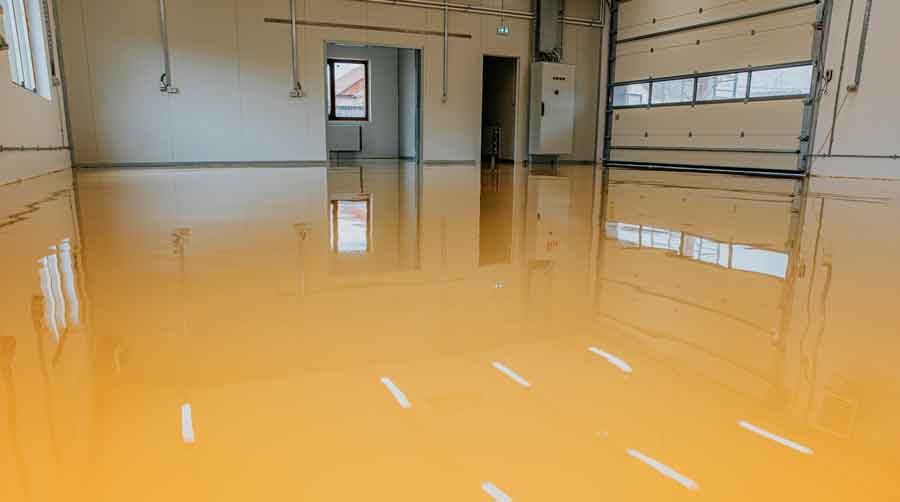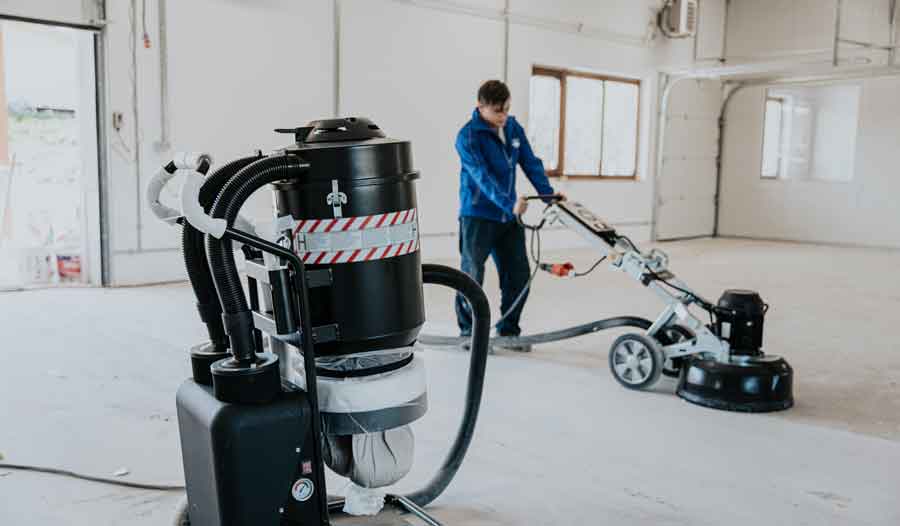If you have an epoxy floor, you know it can lose its shine over time. This happens naturally with regular use, especially if your epoxy floor is in a high-traffic area.
However, harsh chemicals or the wrong cleaning agents can also dull the shine. It has left many people asking how to keep epoxy floors shiny.
There are a few ways to get your epoxy floors shiny and keep them that way:
- Clean the floors regularly.
- Wipe up any spills immediately.
- Put mats under table legs or heavy items, so they don’t scratch the surface.
- Deep clean the floor twice a year, including polishing it if it remains dull.
Epoxy floors are durable, but if your floors have started to lose their shine, you don’t have to leave them that way. It’s frustrating if you’re unsure how to get and keep your epoxy floor shining.
There are many ways to get your floors shining like new. In this post, we will share how easy it can be to get and keep epoxy floors shiny.

How To Keep Epoxy Floors Shiny
When you first install an epoxy floor, they are shiny and look great, but over time, many factors can cause your epoxy floor to lose its shine and become dull.
While you can restore the shine, you need regularly maintain it to keep it shiny.
Here are a few easy methods to get your epoxy floors shining and keep it that way.
Regular Maintenance Cleaning
While epoxy floors are durable, they can get damaged and lose their shine, so they need regular maintenance.
You don’t have to add a new top coat as soon as the shine dulls (once a year is sufficient). However, regularly cleaning your epoxy floor will help you get the shine back.
You should vacuum or sweep the floors weekly and mop them using a general floor cleaner.
Don’t add tons of chemicals to the mop water since it may damage the protective top coat of the epoxy floor over time. Just use warm water, so all the dirt gets cleaned up.
If your floors have a non-slip protective coating, use a soft bristle push-broom instead of a mop to clean the floors.
Mop fibers can get caught in the bumps of the coating, trapping dirt. A soft bristle broom moves more effectively between the non-slip coating’s bumps and won’t get snagged.
Vacuum any hard-to-reach places once a month so the trapped dirt won’t spread and scratch the epoxy floor surface.
Accidental Spills
One of the main factors that can dull an epoxy floor is spills, so clean up spills as soon as they happen. The longer any spill sits on the floor, the more time it has to stain the epoxy.
Simply clean up the spill using a paper towel or soft cloth.
We will discuss getting tough stains later in the post.
Use The Right Kind Of Floor Cleaner
Using the right cleaning agents is essential when trying to keep your epoxy floors shiny.
The wrong cleaning agents can compromise the epoxy’s top coat, stripping away the glossy shine, damaging your flooring, and making it look dull.
Avoid using products or floor cleaners containing acids such as vinegar or citrus (lemon, orange, lime).
Also, avoid using soap-based cleaners. Not only do they leave a film coating behind that leaves floors looking dull, but they also make your epoxy floor slippery.
Diluted ammonia and water are the best cleaners for your epoxy floor. It won’t remove the shine, damage your floors, or create a slippery surface.
To clean epoxy floors, mix 1 gallon of warm water with 2 – 3 ounces of ammonia.
Getting Tough Stains Out Of Epoxy Floors
If you have followed all the maintenance tips, but some spills have left stains behind, you don’t have to be concerned. There are ways to get them out of the epoxy floor without damaging the top coat. Tough stains can come from oil spills, antifreeze, chemical spills, or rust.
Step 1
Try using hot water and the mop without adding a cleaning agent to the water.
Warm water helps lift the stains and typically removes light stains without needing any additional chemicals.
Step 2
Stubborn stains may require adding some ammonia to the water, which helps remove mild to moderate stains.
For additional scrubbing power, use a soft kitchen sponge or kitchen scrubbing pad.
Lightly scrub the stain until it has lifted.
Be careful not to use an abrasive scrubber like steel wool or other metal scrubbers and sponges as they will scratch the epoxy surface.
If the stain is deep set, such as automotive oil or rust, you can use a cleaning agent such as Windex or Soft Scrub. These cleaners won’t damage or scratch the protective top layer.
You can clean the stain by dipping the kitchen scrubber in warm water and cleaning agent and scrubbing lightly until the stain comes out.
Step 3
After cleaning all the stains, you should wash the entire floor with the ammonia and water mixture, which helps clean and restore the shine.
Deep Clean Epoxy Floors
Deep cleaning your epoxy floors every three months will help restore the shine that regular wear and tear from high traffic and a lot of use has dulled.
Here are the steps that will restore the shine on your epoxy floor.
Step 1
Remove all the furniture, tables, tools, cabinets, cars, etc. from the floor and out of your way.
Step 2
Mix your cleaner (ammonia or something like Simple Green) into the water.
Adding too much of the cleaning agent can leave a film, so don’t use more than ½ cup (120ml) of cleaner to a gallon of water.
Step 3
Use a hard foam mop to get deep into the floor’s surface.
Ensure you have a bucket of the cleaning agent and hot water mixture and a bucket of plain hot water.
Submerge the mop in the cleaning solution, wring out the excess and thoroughly mop the floor.
Step 4
Use the clean water to rinse the cleaning solution from the floor so it won’t leave a sticky residue, then dry with a clean towel.

How To Polish Epoxy Floors
If you see the shine on the epoxy floor is not as bright as you would like, you can polish it to make it look almost new. Here is how;
Step 1 – Sanding
Before you can polish the floors, you need to sand them lightly.
The sanding removes all the built-up oils, dirt, cleaning agents, and damage to the top layer of the epoxy floor.
You can do this by hand with an orbital sander or a floor-sander for large sections.
Start with 1200 grit sanding paper and work up to 4000 grit sandpaper for a glossy finish.
Step 2 – The Polishing
After the floor’s surface is prepared, you can use a polishing machine, which you can rent at some hardware stores.
Read the instructions thoroughly and add the correct polishing compound. Experts recommend using a polishing paste for synthetic resin floors.
Follow the instruction manual, attach the recommended polishing attachment, and plug the machine in.
To reach the entire floor surface, ensure you use an extension cord that is the correct length.
Working in small sections, take some of the paste and add it to the floor.
Then turn the machine on and start buffing the floor, holding onto the machine at the handle.
The polishing machine will work in elliptical and rotating movements to ensure the entire surface is polished to a shine. Continue this until the entire floor has been polished.
This method is fast, very easy, and recommended for beginners.
Reapplying An Epoxy Sealant
If your epoxy floor hasn’t been properly maintained, the problem might be a poor quality sealant. The floor’s sealant may have been damaged and is now creating a dull cast on the epoxy floor.
You should purchase a high-quality epoxy sealant, then take the same steps to do a deep clean on the floors.
After the epoxy floor is bone dry (wait a few hours), you apply the sealant to get the epoxy floors shining like new again.
You can also take preventative measures like the ones listed below to ensure the sealant is protected in the future.
Use Mats Or Rubber Stoppers
If you need ways to keep your newly restored epoxy floor shiny, then you need to use mats or rubber stoppers on the furniture in the room.
Things like table legs, bike tires, stands, cars, metal cabinets, tools, etc. can all cause damage to the floor, they can scratch the top coat, or if you have a sealant, they can damage and dull the sealant over time.
If you need to move something out of the room with an epoxy floor, use old rags or an old blanket on top of the floor so it won’t damage it.
Wrapping It Up
If you have a dull epoxy floor, you can restore the shine with regular maintenance, using the right cleaning agents, and occasional polishing.
Because epoxy resin floors are so durable, by following the instruction in this post, you should be able to keep them shiny with ease.
